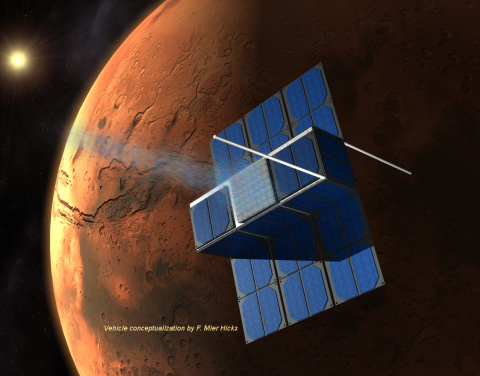HARTFORD, Conn.--(BUSINESS WIRE)--An international team of university students announced today they are evaluating the options and technologies to build and launch a small spacecraft to Mars. The vehicle would carry a unique payload: a two-inch-diameter titanium sphere containing perhaps millions of digital photos, videos, audio files, and text messages from people all over the world.
The students are proposing to fly their "time capsule of humanity" to Mars on a few-foot-long spacecraft based on the "CubeSat" platform that has become increasingly popular for Earth-orbiting missions. This would be the first time a CubeSat would be flown to another planet. It would also be the world's first interplanetary space mission led by a non-government team. Early details of the mission can be seen here: www.TimeCapsuleToMars.com.
The students are supported in their quest for Mars by a consortium of substantial entities, including MIT, Explore Mars, and Remarkable Technologies, Inc.
"This would be an extraordinarily challenging mission -- a game changer," said Dr. Paulo Lozano, Director of the MIT Space Propulsion Lab (http://web.mit.edu/aeroastro/labs/spl/). Lozano continued, "The first step is figuring out the feasibility by determining the expected performance and availability of small-satellite technologies. The students are targeting the end of this upcoming January to review and fine-tune the options -- and establish a detailed plan for a potential mission going forward."
As a first option, the students are proposing to use Electrospray Thrusters for spacecraft propulsion (http://web.mit.edu/aeroastro/labs/spl/research_ieps.htm). The current plan is to launch the spacecraft into orbit as a secondary payload of a commercial space launch, and then accelerate the spacecraft to escape velocity -- and on its course to Mars -- using the vehicle's Electric Propulsion thrusters.
MIT Master's student, Caleb Whitlock, who works in the Space Propulsion Lab, said "It’s a privilege to be involved in such an exciting program. It promises to be a fascinating endeavor -- an engineering challenge that energizes all of us who have looked skyward since we were kids." Whitlock continued, "Leaving a lasting mark on another planet is an enthralling prospect as is designing a system capable of doing so. It will push the limits of engineering education. It will also inspire the next generation of technical minds to accomplish extraordinary feats in science and space."
"Explore Mars (www.ExploreMars.org) is excited to support such an inspiring, student-led space mission," commented Explore Mars Executive Director, Chris Carberry. "It will not only utilize innovative new technologies, but it will also be one of the most inspiring and historic student missions ever attempted."
Eric Knight, Founder and President of Remarkable Technologies, Inc. (www.remarkable.com), said, "This project is being done without profit by all supporting entities. We're essentially giving the tools and resources to the students and saying, 'Go for it.'" Knight added, "I can't imagine a more worthwhile initiative to be part of. It encompasses all citizens of the world. And it's led by the world leaders of tomorrow -- our students -- with the goal of accomplishing something extraordinary...in fact, historic: to land a multi-media representation of all humankind on another planet. It doesn't get any better than that."
Million-year time capsule
Individuals from around the world will be able to upload their digital creations to www.TimeCapsuleToMars.com. For the voyage to Mars, and then the permanent resting place on the planet's surface, the digital files will be stored on the new quartz media -- being developed by such entities as Hitachi, Kyoto University, the University of Southampton, and others -- that promises literally millions of years of durability. One example: http://www.scientificamerican.com/article.cfm?id=data-saved-quartz-glass-might-last-300-million-years. Another example: http://spectrum.ieee.org/semiconductors/memory/data-for-the-31st-century.
The entire mission will be paid for by worldwide crowdfunding, with individuals having their digital creations survive for millennia on Mars for as little as 99 cents. "If we inspire millions to participate, this would be the largest crowdfunding effort in history," said Emily Briere, of Duke University’s aerospace engineering program. "Our goal is to give everyone, everywhere the opportunity to be part of this grand adventure. Every penny of the money raised will go directly to our student-led project. 100%."
Protecting the Mars ecosphere is an important design criteria
The team is designing the spherical Mars lander to be easily sterilized before launch, to make sure it does not inadvertently transport microorganisms to the Martian surface. Its mirror-smooth finish will simplify sterilization, exceeding safeguard levels established by NASA's Office of Planetary Protection and the international Committee on Space Research (COSPAR).
Looking for out-of-this-world names for the spacecraft and lander
While the students are working on the essential science, they are also looking for creative names of both the spacecraft and the Mars "time capsule" lander. The goal is to unleash the world's creativity in every aspect of the program. The individuals who submit the chosen names will get special digital allocations in the time capsule's quartz memory, as well as other unique tributes. To submit your name ideas, visit www.TimeCapsuleToMars.com.




